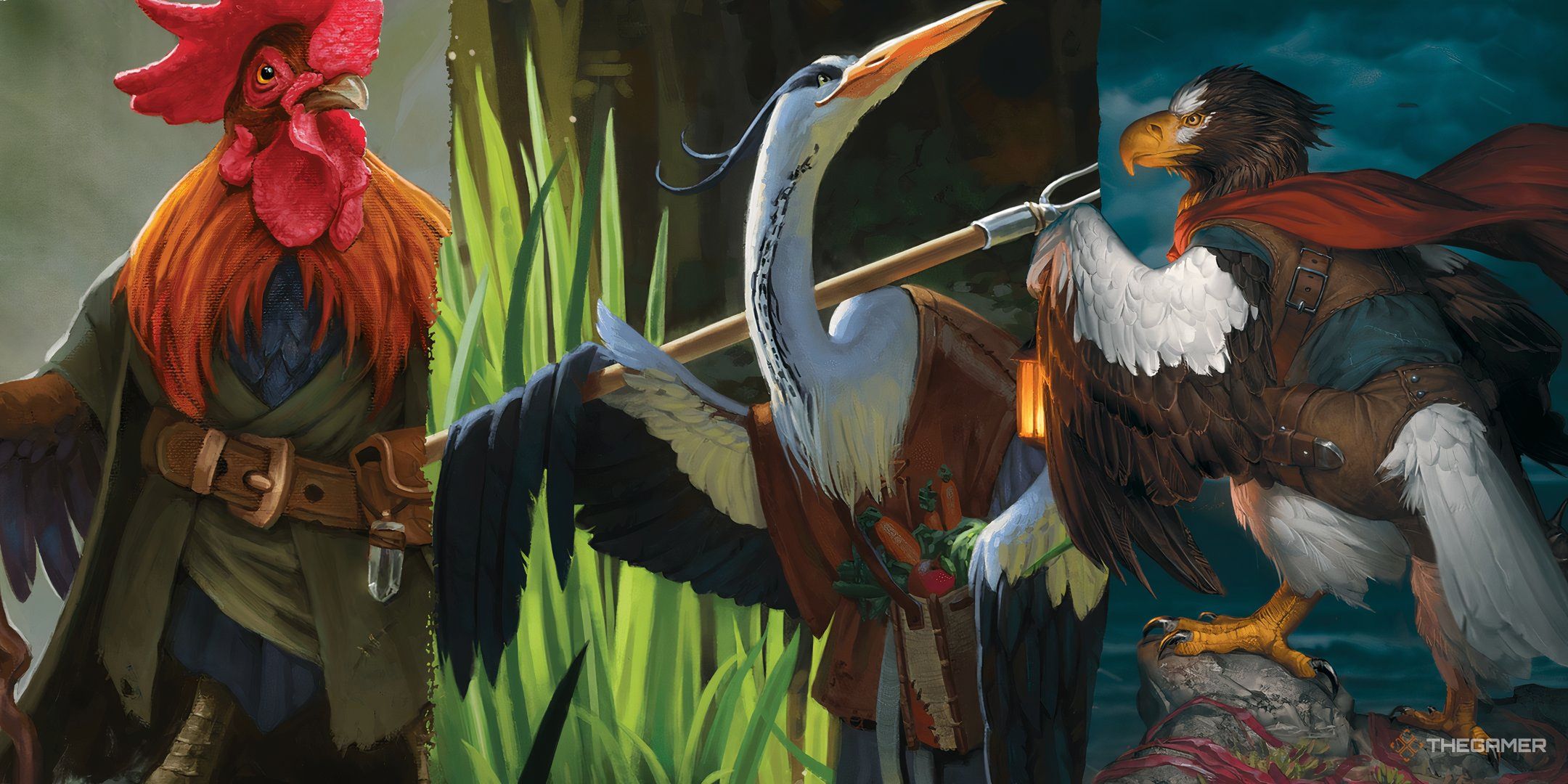Dungeons & Dragons: Humblewood Birdfolk Species Guide

Quick Links
- What Are Birdfolk?
- How Birdfolk Flight Works
- Which Birdfolk Should You Play?
In the Humblewood campaign setting for Dungeons & Dragons, there is a playable species known as the birdfolk. These creatures resemble a variety of different real-world birds, and come in a ton of different shapes, sizes, and plumages. Living in settlements or perches high above the Humblewood, they are powerful and diverse.
RelatedDungeons & Dragons: How To Build A Scofflaw Fighter
Looking for a new fighter subclass to try? Here's how to build a scofflaw fighter from the Humblewood campaign setting in DND.
PostsIf you're planning to play in the Humblewood campaign setting for the first time, you're going to want to consider playing a birdfolk. But, you might be wondering how these creatures work, and what builds work best for birdfolk. Here's everything you need to know about birdfolk in Dungeons & Dragons.
What Are Birdfolk?
Birdfolk Dockmaster by Leesha HanniganIn Humblewood, there are two manner of creatures: birdfolk and humblefolk. Birdfolk represent the flying creatures of the forest, and can resemble crows, doves, and more.
Beyond their external appearances, the birdfolk have made themselves the dominant political force within Humblewood and are responsible for founding their capital in the tree known as Alderheart.
They also have a birdfolk council, which rules over all of Humblewood.
Here's a quick breakdown of the different types of birdfolk you can play as:
Birdfolk
Ability Score Improvement
Bird Inspiration
Key Feature
Corvum
Intelligence +2
Crows, Ravens
Ability to appraise the value of objects, as well as their possible uses, once per short or long rest.
Gallus
Wisdom +2
Chickens, Turkeys
Proficiency with simple weapons and one additional artisan tool.
Luma
Charisma +2
Doves, Pigeons
Ability to reroll any attack, skill check, or saving throw once per long rest.
Raptor
Dexterity +2
Hawks, Eagles
Can treat three-quarters cover as half cover and half cover as no cover.
Strig
Strength +2
Owls
Advantage on Stealth checks when hiding in a forest.
In addition to these core species for birdfolk, each birdfolk species has two subspecies that offer additional specializations and skill improvements, which can all help round out your character build in various ways.
As you can see, no base birdfolk has an ability score improvement for Constitution.
However, two subspecies of birdfolk have improvements to Constitution, such as the Sable Luma and the Stout Strig.
How Birdfolk Flight Works
Luma by Andrea RadeckDespite their differences, all birdfolk have one thing in common: they can all glide.
While other species in Dungeons & Dragons might have flight speeds, to keep things balanced, the birdfolk all have what's called a glide speed.
Many birdfolk also have abilities like darkvision and talon attacks.
Gliding has two main elements to its ruleset:
- Slow Fall - When falling, you can use your reaction to glide, continuing your fall gently at a speed of 60 feet per round, taking no fall damage when you land.
- Flight Speed - If, while gliding, you would fall at least 10 feet, you may then choose to fly up to your movement speed, but you cannot gain elevation.
Additionally, it should be noted that you cannot glide while carrying heavy weapons, donning heavy armor, wielding a shield, or are encumbered.
Which Birdfolk Should You Play?
Strig by Christina KrausOf course, when it comes to selecting which birdfolk you should play, you're going to want to base your decision based off what class you want to play.
Unlike in the 2024 Player's Handbook, the Humblewood campaign setting makes use of what's known as 'Legacy Content.'
This means that ability score improvements are doled out via species rather than backgrounds. Talk to your DM about whether they plan to use any content from the 2024 PHB or beyond in their campaign.
Different birdfolk and birdfolk subspecies are better at different things. Here's a quick overview of some of the best birdfolk species/class combinations:
Birdfolk Species
Best Classes
Details
Corvum
- Wizard
- Rogue
- Sorcerer
Corvums gain a +2 to their Intelligence, making them excellent wizards.
However, dusk corvums also gain a +1 to their Dexterity and bonuses to their Stealth, making them great rogues.
Kindled corvums also gain a +1 to their Charisma, which can be helpful for sorcerers.
Gallus
- Cleric
- Druid
- Ranger
Because galluses gain a +2 to Wisdom, they make for excellent druids and clerics.
Additionally, the huden gallus subspecies gains a +1 Dexterity, which can prove helpful for rangers.
Luma
- Bards
- Paladins
Lumas gain a +2 to their Charisma, ideal for bards and paladins.
If playing a bard, select the sera luma for proficiency in the Performance skill.
If playing a paladin, select the sable luma for an increase to your Constitution.
Raptor
- Monks
- Fighters
- Rogues
- Rangers
Thanks to their +2 in Dexterity, raptors make for great martial and ranged fighters.
The mistral raptor gains a +1 to their Wisdom, helpful for monks.
Strig
- Fighters
- Barbarians
Strigs make for the best martial classes in Humblewood thanks to their +2 to Strength.
For barbarians, select the stout strig subspecies for a bonus to Constitution.
For fighters, select the swift strig for a bonus to Dexterity.
read more.
NextDungeons & Dragons: How To Build A Community Domain Cleric
Whether you're playing in the Humblewood campaign setting or not, the community domain subclass for cleric is a fantastic option in DND.
Posts












